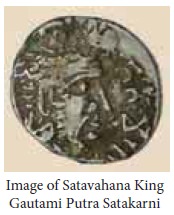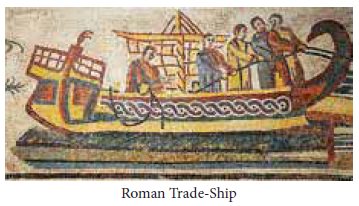Post-Mauryan Period | History - The Tamil Kingdoms | 11th History : Chapter 6 : Polity and Society in Post-Mauryan Period
Chapter: 11th History : Chapter 6 : Polity and Society in Post-Mauryan Period
The Tamil Kingdoms
The Tamil Kingdoms
Southern India remained immune to the political changes taking place in the northern part of the country. Around the first century CE, the Satavahana kingdom was established in the Deccan area, comprising the modern state of Andhra Pradesh

and Telangana. This, however, was not like the centralised empire of the Mauryas, and the provincial governors of the Satavahanas had a considerable degree of autonomy.
The political landscape of the Tamil region was fragmented into small kingdoms, in contrast to the north where extensive empires flourished. The Tamil region was ruled by muvendar, the three kings – the Pandyas from their capital Madurai, the Cholas from their capital Uraiyur (now a suburb of the city of Tiruchi), and the Cheras from Vanji (modern-day Karur).
We know that these kings were known to the Mauryas even in the 3rd century BCE and Asoka’s second rock edict mentions them as kingdoms bordering his empire. However, there were many war lords and chiefs (often referred to as velir) who were ruling over smaller principalities in the region.
We have extensive information about the Tamil region coming from the corpus of Tamil poetry collectively known as the Sangam literature, dating from the third century BCE to the third century CE. To these we can add the epics Silappadikaram and Manimekalai, which were written somewhat later. The very large volume of trade with the Tamil region evoked a great deal of interest among the Roman and Greek historians and geographers, and their accounts complement the information in the Tamil sources, especially with respect to trade. A first century CE account in Greek, the Periplus of the Erythrean Sea (Periplus Maris Erythraei), is the most reliable source of information on the ports of the Indian coast and trade. Archaeological findings confirm the information from all these sources.
Contours of International Trade
Two major developments changed the contours of trade between Europe and India towards the beginning of the Common Era. By the end of the last century BCE, Rome emerged as the superpower of the Mediterranean world, displacing the Greek kingdoms, and the republic became an empire in 27 BCE under Emperor Augustus. Rome was the largest and, probably, the wealthiest city in the world commanding huge resources realised through conquests in Europe and North Africa. The wealth of Rome greatly increased the demand for various products from India, especially the spices and textiles of the Tamil country, resulting in a great expansion of trade.

The second development was the discovery of the pattern of monsoon winds in the Arabian Sea in the first century CE by Hippalus, an Egyptian sailor. Till then, the sea trade between India and the Mediterranean world was controlled by the Arabs. Arabs had a monopoly of the knowledge of the source regions of products such as cinnamon and pepper, which formed the main export to Rome. But when the information about the direct sea route became common knowledge, Roman ships began to sail directly to the western coast of India. They could thus avoid sailing close to the coastline, which made them vulnerable to attacks by pirates. Further, this also meant that the overland route could be circumvented completely, since traders on that route were also vulnerable to attacks by Parthians in Iran. The ultimate result of the combination of the growing demand from Rome and the opening of the direct sea route to western India was a increase in the number of ships sailing to India from about twenty ships a year to almost one ship a day.
Related Topics